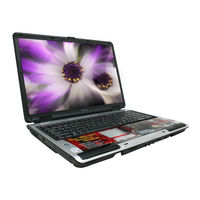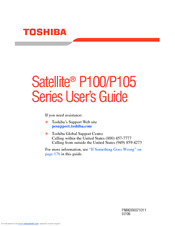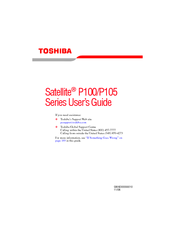Toshiba P105-S931 Laptop Charger Manuals
Manuals and User Guides for Toshiba P105-S931 Laptop Charger. We have 3 Toshiba P105-S931 Laptop Charger manuals available for free PDF download: User Manual
Toshiba P105-S931 User Manual (278 pages)
P105-S9337 User's Guide
Table of Contents
-
Introduction34
-
This Guide35
-
Safety Icons36
-
-
-
-
Saving Files89
-
File Names90
-
-
-
-
Battery Notice103
-
Power Management104
-
-
Traveling Tips121
-
-
Using PC Cards138
-
-
TOSHIBA Assist147
-
Connect148
-
Secure149
-
Protect & Fix150
-
Optimize151
-
-
Mouse Utility160
-
-
-
-
A Plan of Action186
-
Memory Problems191
-
Display Problems194
-
PC Card Problems201
-
Printer Problems204
-
Modem Problems205
-
-
-
Volume Mute223
-
Power Usage226
-
Standby Mode227
-
Hibernation Mode228
-
Display Modes229
-
-
-
Computer233
-
-
-
Getting Started234
-
-
Profile Settings244
-
Quick Connect252
-
Glossary257
-
Index272
-
Advertisement
Toshiba P105-S931 User Manual (275 pages)
P100-ST7211 User's Guide
Table of Contents
-
-
Introduction34
-
This Guide35
-
Safety Icons36
-
-
-
-
-
Standby Mode74
-
-
-
-
Saving Files88
-
File Names89
-
-
-
-
Battery Notice102
-
Power Management103
-
Traveling Tips120
-
-
-
Using PC Cards136
-
-
TOSHIBA Assist144
-
Connect145
-
Secure145
-
Protect & Fix146
-
Optimize147
-
-
Mouse Utility156
-
-
-
-
A Plan of Action183
-
Memory Problems187
-
Display Problems191
-
PC Card Problems197
-
Printer Problems201
-
Modem Problems202
-
-
-
Volume Mute220
-
Power Usage223
-
Standby Mode224
-
Hibernation Mode225
-
Display Modes226
-
-
-
Toshiba Computer230
-
-
-
Getting Started231
-
-
Profile Settings241
-
Quick Connect249
-
Glossary254
-
Index269
-
Toshiba P105-S931 User Manual (237 pages)
P100-ST1072 User's Guide
Table of Contents
-
Introduction33
-
This Guide34
-
Safety Icons35
-
-
-
-
-
Battery Notice101
-
Power Management102
-
-
Traveling Tips117
-
-
Using PC Cards130
-
-
TOSHIBA Assist137
-
Connect138
-
Secure139
-
Protect & Fix140
-
Optimize141
-
-
Mouse Utility148
-
Configfree165
-
Getting Started166
-
-
-
-
-
A Plan of Action175
-
Memory Problems177
-
Display Problems180
-
PC Card Problems185
-
Printer Problems187
-
Modem Problems187
-
-
-
Hot Key Cards201
-
-
Card Case204
-
Advertisement
Advertisement


